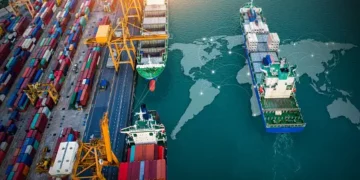In 2022, Amazon significantly scaled back its investments in international logistics operations as it aimed to control costs in the face of warehouse overcapacity and a deceleration in retail sales. The world’s largest e-commerce company committed to investing approximately $1.53 billion in logistics, distribution, and transportation activities outside the US. This marked an 80% reduction from the over $7.5 billion invested in each of the two previous years. The data, sourced from fDi Markets, a greenfield investment monitor, revealed that this level of investment was the lowest in a decade, with the last similar figure recorded in 2013 at $765 million. Consequently, Amazon lost its position as the leading non-oil logistics investor globally.
In contrast to Amazon’s scaled-down approach, several other prominent investors increased their global capital expenditure plans in 2022. For instance, German logistics group Deutsche Post raised its investment by 19% to $3.16 billion, and Danish shipping company AP Moller-Maersk pledged its highest-ever amount of $2.82 billion to logistics foreign direct investment (FDI) projects, as reported by fDi Markets.
In 2022, Amazon’s share of global logistics FDI dwindled to just 2.2%, a significant drop from nearly 13% in 2021. Arhi Kivilahti, a retail analyst at Ada Insights, pointed out that Amazon’s international business, which was anticipated to be a growth driver, has lagged behind its North American operations. The challenges faced by Amazon in markets like China and India have raised questions about the sustainability of pouring funds into unprofitable international ventures.
The decrease in Amazon’s foreign logistics investments followed a massive expansion of its network to meet the surging demand for online shopping during the pandemic. In the two years leading up to the end of 2021, Amazon added over 255 million square feet to its global warehouse network. However, in the first quarter of 2022, Amazon reported additional costs of $2 billion due to overcapacity in its fulfillment and transportation network. Estimates from MWPVL International, a consultancy, suggested that Amazon’s utilization of its global warehousing capacity had fallen to less than two-thirds, down from 85% in 2019.
In addition to cutbacks in logistics, Amazon made other significant decisions, including laying off 18,000 workers in January 2023 and pausing the construction of its second US headquarters in Arlington, Virginia.
Discover supply chain logistics news updates on The Supply Chain Report. Free international trade tools are available at ADAMftd.com.
#AmazonLogistics #GlobalFDI #ECommerceTrends #LogisticsInvestments #SupplyChainUpdates #RetailChallenges #WarehouseOvercapacity #DeutschePostLogistics #MaerskInvestments #GlobalTransportation #AmazonWarehouse #PandemicImpact #LogisticsStrategy #RetailAnalystInsights #GreenfieldInvestments

















